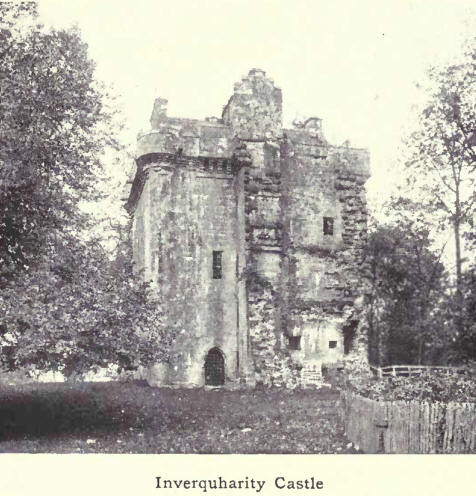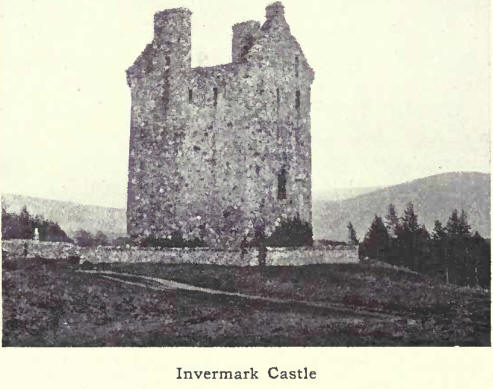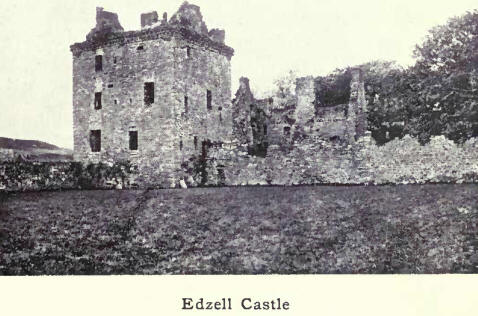|
Amongst military
structures in Scotland, there are said to be no examples of the
Norman style. Our oldest castles belong to the succeeding period.
The typical fortress of the early fifteenth century was the simple
square tower with three or four vaulted storeys. Such is Melgund
castle. In order to provide for some flanking work, the builder of
these square towers often perched turrets on the corners or top of
the building. There might be four of these works, but often the
poverty of the laird restricted him to one or two. After the long
quarrel with England, Scottish architects adopted French rather than
English models. Some of the distinctive features of this Scottish
baronial style, for which we are in part indebted to our French
allies, are turrets projecting from the wall upon bold corbellings
and terminating in pointed roofs; towers of circular plan; parapets
and battlements; roofs of steep pitch; gables of stepped outline;
small, square windows; plain, unadorned doorways ; prominent or
lofty chimneys.
Fortresses are
situated at points of vantage amongst or near the hills, where they
have been erected to guard some pass or ford, or at places on the
coast liable to attack. Forfarshire, for example, has its castles
placed at, or near, the entrances to glens leading far into the
Grampians, at passes in the Sidlaws, at important strategic points
in Strathmore and Strathmartine, and on or near the shore of firth
and ocean.
Situated in Glen Isla
at a point to the north-east of Mount Blair, and commanding the
route through that glen and one leading over to Glen Shee, Forter
Castle, an ancient stronghold of the Ogilvys, is a good example of a
mountain keep. It has long been in ruins, but a special interest
attaches to it as the actual scene of the burning of what in the
ballad is called the “bonnie house o’ Airlie.” The Earl of Airlie
was obnoxious to the Covenanters and devoted to the Stewart cause.
During his absence in England in 1640, Argyll as leader of the
Covenanters and in prosecution of an old family feud between the
Campbells and the Ogilvys, attacked and destroyed both Forter and
Airlie. The latter castle occupies a romantic position at the
junction of the Melgum and the Isla. The precipices rising from both
stream and tributary rendered it impregnable on all but its landward
side, which was defended by a deep fosse, drawbridge, and
portcullis.

One of the finest
ruins of the county, Inverquharity Castle, is situated on the South
Esk near the point where that river is joined by the Carity Bum. It
formed another of those defences against raiders down Glen Prosen or
Glen Clova. Built by one of the Ogilvys, it is a large, square,
battlemented tower, with walls 9 feet thick. The castle possesses
one of the few iron gates, or “yetts,” met with in the county, for
the use of which a special licence from the sovereign was required.
In the neighbourhood are the ruins of Clova Castle. Cortachy Castle
at the junction of the Prosen and the South Esk, has a name that is
said to indicate the nature of its site— “the enclosed ground.” Shut
in from the surrounding world by hills and woods, it is built in an
ideally sequestered spot. Like so many others in Forfarshire the
castle consists of portions built at separate periods; but not even
its oldest part, a circular tower terminating with a square
corbelled superstructure, looks as if it had been a fortress, though
in the early sixteenth century, when it seems to have been built, it
must have served to some extent as a place of defence as well as
residence.

Vayne Castle, amidst
the Braes of Angus between the two Esks, is situated on a
precipitous rock overlooking the Noran. The castle, built of red
sandstone, consisted of three storeys and had a circular tower
containing a staircase. Probably a stronghold of the Lindsays, it is
another good instance of a fortress built to guard against northern
forays.
Finhaven Castle,
whose ruins may still be seen near where the Lemno joins the South
Esk, was for a long time the chief seat of the Lindsays, Earls of
Crawford. James II defied the notorious Earl Beardie and vowed he
would make the highest stone of the castle its lowest. He
subsequently pardoned the Earl, but to fulfil his vow—
“Bounding nimbly to the highest
tower,
Where Beardie wont to pass his leisure hour,
Down to the lawn a crazy stone he threw,
And smiling cried—‘Behold my promise true!’”

Glenesk, even more
closely associated with the.“lichtsome Lindsays,” contains two
interesting memorials of that warlike family. Amid the rocky
fastnesses near the head of the glen, rises the ruinous tower of
Invermark Castle, the most typical specimen probablyin the whole
county of a mountain fortress. Built of native granite, the tower is
one of four storeys, with the entrance on the second floor, now
somewhat difficult of access. In days of yore it was reached by a
drawbridge stretching between the castle and a flight of steps 12
feet distant. Should an enemy have succeeded in crossing this he
would have found the doorway guarded by a strong iron “yett,” within
which was an oaken door.
Near the entrance to
Glenesk stood Edzell Castle, whose ruins form the most impressive
relic in the county of a medieval fortress and baronial residence.
It vied with Finhaven as a seat of the Lindsays. The ruins of the
castle testify to the greatness of this family. The lofty “Stirling
Tower,” a keep 60 feet in height, still fairly entire, is the most
imposing part of the ruins. The great baronial hall measured 36 by
24 feet. The courtyard was 100 feet in length by 70 feet in breadth.
The castle and its gardens covered about two acres of ground. The
gardens were surrounded by walls ornamented with sculptures and
decorations, which may still be seen. Its kitchen, “the Kitchen of
Angus,” was so large that a whole ox could be roasted in it; and
need was, for crowds of noble guests and their retainers were
constantly received within the hospitable walls of the castle.
Hatton Castle, near
Newtyle, was a fortress of the Oliphants, built in 1575 and
noteworthy for the size of its rooms and its window apertures. Some
little distance over the pass leading from Newtyle to the valley of
the Dighty is the mansion of Auchterhouse. In its grounds is the
so-called Wallace Tower, with walls 12 feet thick. This has the
reputation of belonging to the early twelfth century; and, if so, it
is one of the oldest ruins in the county. The association of its
name with the national hero is consistent with the tradition that it
was for some time occupied by Edward I.
For centuries the
chief seat of the Earls of Strathmore has been Glamis Castle, one of
the noblest architectural ornaments of Angus, and the finest
specimen in existence of the Scottish baronial style. We are here
concerned mainly with the older parts of the building, the
construction and character of which take us back to the eleventh
century. The room is still shown in which, according to tradition,
Malcolm II died, in 1033. Another account speaks of a violent death,
and certain obelisks with rude carvings in the vicinity seem to bear
testimony to this. The truth can never be known; but the king’s
death being associated with Glamis bears undoubted witness to the
antiquity of the castle. The demesne came into the possession of the
Lyons in 1372, the founder of the Strathmore family being Sir John
Lyon, who married the Princess Jane, second daughter of Robert II.
Weird stories, ghostly and other, cling to the haunted rooms of
Glamis Castle. Residence as it now is and long has been, the
enormous walls, the small windows, the arched and groined roofs
bespeak the fortress, and justify us in ranking Glamis amongst
military buildings.
Forfar Castle has now
disappeared, but its ruins were in evidence about the beginning of
last century. It was an important fortress in the early days when it
was captured by Edward I and so obstinately held for him, that on
its being reduced Robert I caused it to be destroyed lest it should
again harbour his enemies. Its site is now occupied by the tower of
the Market Cross. The district that intervenes between Forfar and
Brechin contains the castles of Careston, Melgund, Flemington, and
Aldbar, in addition to Finhaven already mentioned. Melgund, which
resembles Edzell, is perhaps the most interesting of these, and is
associated with the name of Cardinal Beaton.
The nucleus of
Brechin Castle is as old as the time of Wallace. Edward I occupied
it for some time in 1296, and in the following year Wallace took it.
Edward now directed a strong force against the Castle, which, after
a hot attack lasting for twenty days, surrendered on the death of
its brave governor, Sir Thomas Maule. The fortress occupies a strong
natural position, around which on one side sweep the waters of the
South Esk. In the fifteenth century it came into the possession of
the Maules of Pan-mure, and is now the chief seat of the Earl of
Dalhousie.
Almost directly south
of Brechin and about halfway between that city and Arbroath, rises
to a height of 60 feet the massive square tower of Guthrie Castle.
Its age is uncertain, but it seems to date from the fifteenth
century, when Sir David Guthrie obtained permission to erect such a
fortress-residence as the times required. Its iron “ yett ” is a
noteworthy feature. The old tower is incorporated in the modern
castle.
Historically more
interesting was the ancient Castle of Kinnaird, whose site is now
occupied by what is perhaps the most sumptuous mansion in Angus. The
old castle was burned by Earl Beardie in 1452, because its owner
fought against him at the battle of Brechin. James VI, Charles I,
and Charles II were guests in the building which replaced it; and
Charles I created its owner Earl of Southesk. It was here that the
Great Marquis, who had married a daughter of the house, parted from
his wife when on his way to execution at Edinburgh. James, the fifth
earl, an active Jacobite in the Fifteen, suffered the forfeiture of
his title and his estate for his adherence to the Stuarts, and died
in exile. In 1855 his great-grandson was reinstated by the House of
Lords.
Near Montrose are the
castles of Rossie and Dun-ninald, while to the north-west of
Montrose Basin are the remains of the ancient House of Dun, whose
proprietors for many generations figured notably in Scottish
history. Their rights of harbourage at Montrose brought them into
frequent and often serious conflict with the inhabitants of that
ancient borough.
Two miles west of
Dundee is Invergowrie House, the oldest part of which is believed to
go back to the fourteenth century. Of the Castle of Dundee nothing
remains but the name. Dudhope Park in Dundee, purchased in 1873 as a
recreation ground for the city, contains the Castle of Dudhope, a
place of some historical note. The oldest part of the building was
erected in 1296 by Sir Alexander Scrymgeour, and being subsequently
extended became the seat of the Scrymgeours, Earls of Dundee. The
property is described in 1682 as being “ane extraordinaire pleasant
and sweet place.” It was the abode of the celebrated Claverhouse. In
its vicinity he unfurled King James’s banner and from it set out for
Killiecrankie.
Broughty Castle was
founded in 1496, and played many notable parts in history down to
1603. Having long fallen into disuse as a fortress, it was repaired
and fortified by the Crown to guard the entrance to the Tay. For
this it is admirably suited, being situated on a rocky promontory,
once an islet, at the point where the estuary of the Tay narrows to
a breadth of one mile. Its guns thus command the entrance of the
firth and the waterway to Dundee.
In the district to
the north-east of Dundee and Broughty Ferry are several castles,
once half fortresses, half mansions. Amongst these the most
interesting are Mains, Claypotts, and Affleck, all now in a more or
less ruinous condition. Mains, or Fintry, Castle was built about
1562 by Graham of Fintry; and, though long uninhabited, is in a
state of wonderful preservation. It is situated on a tributary of
the Dighty, and its lofty tower is a conspicuous object in the
landscape. It is a good example of the castellated architecture of
the sixteenth century. The tower has a penthouse corona. The
corbelled abutment of a turret, the arched entrance, the quaint
gables are noteworthy features. That it was more residence than
stronghold, its situation and its ornate character alike show.
Immediately behind Broughty Ferry is Claypotts Castle, of Scottish
baronial architecture. It is built on the Z plan, and belongs to the
latter part of the sixteenth century. Its oblong keep measures 35
feet by 25. The thickness of its walls and its circular towers
bespeak the fortress. Built by the Strachans of Claypotts, the
castle came into the possession of the Grahams of Claverhouse, and
Viscount Dundee resided for some time within it. The ruin is now the
property of the Earl of Home. Affleck, or Auchinleck, Castle, a mile
to the west of Monikie, is regarded as a fine specimen of its class.
From this castle hints have been taken for the restoration of other
buildings of the same type. Like Invermark and a few other Angus
castles, this finely built structure had until recently a “yett” or
heavy door of grated iron. The lofty square tower, a landmark to
mariners, is four storeys in height and has the appearance of a
Border peel. The walls are of great thickness and solidity.
About the middle of
the curve of Lunan Bay, on an elevated piece of ground, stands the
roofless ruin of Red Castle. Erected by William the Lion, it is
thought to occupy the site of a still older fortress built to guard
the entrance to Strathmore. |

